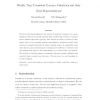Free Online Productivity Tools
i2Speak
i2Symbol
i2OCR
iTex2Img
iWeb2Print
iWeb2Shot
i2Type
iPdf2Split
iPdf2Merge
i2Bopomofo
i2Arabic
i2Style
i2Image
i2PDF
iLatex2Rtf
Sci2ools
FS
2016
2016
Weakly time consistent concave valuations and their dual representations
We derive dual characterizations of two notions of weak time consistency for concave valuations, which are convex risk measures under a positive sign convention. Combined with a suitable risk aversion property, these notions are shown to amount to three simple rules for not necessarily minimal representations, describing precisely which features of a valuation determine its unique consistent update. A compatibility result shows that for a time-indexed sequence of valuations it is sufficient to verify these rules only pairwise with respect to the initial valuation, or, in discrete time, only stepwise. We conclude by describing classes of consistently risk averse dynamic valuations with prescribed static properties per time step. This gives rise to a new formalism for recursive valuation.
| Added | 03 Apr 2016 |
| Updated | 03 Apr 2016 |
| Type | Journal |
| Year | 2016 |
| Where | FS |
| Authors | Berend Roorda, Johannes Schumacher |
Comments (0)

